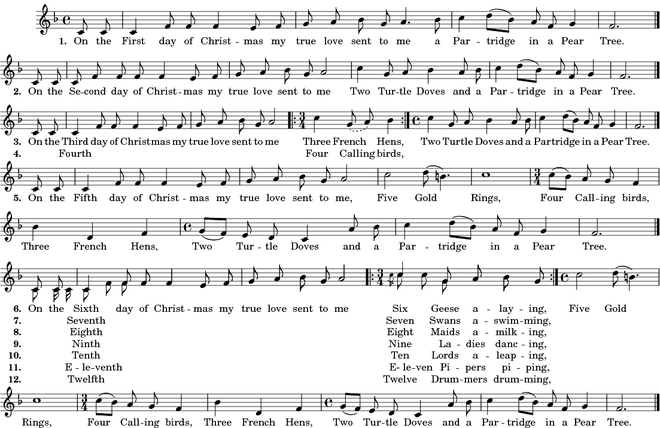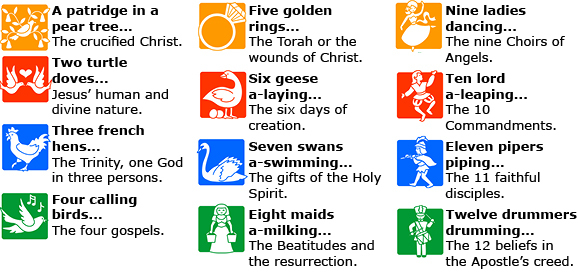Have you ever wondered about how the 12 days of Christmas came about? What it means? There is a very interesting story and some very cool history about this Christmas carol.

We found an excellent blog post written on vox.com and thought this would be a great time to share…
It might seem unbelievable given that the “Christmas creep” now begins before Halloween, but the true Christmas season actually starts on Christmas Day itself. That’s right: December 25 marks the official start of the 12 days of Christmas, the Christian tradition that shares its name with a relentlessly stick-in-your-head Christmas carol.
Here are a few things you may not know about the song and the season.
What are the 12 days of Christmas?
The 12 days of Christmas is the period that in Christian theology marks the span between the birth of Christ and the coming of the Magi, the three wise men. It begins on December 25 (Christmas) and runs through January 6 (the Epiphany, sometimes also called Three Kings’ Day). The four weeks preceding Christmas are collectively known as Advent, which begins four Sundays before Christmas and ends on December 24.
Some families choose to mark the 12-day period by observing the feast days of various saints (including St. Stephen on December 26) and planning daily Christmas-related activities, but for many, after December 25 things go back to business as usual.
“The 12 Days of Christmas” is also a Christmas carol in which the singer brags about all the cool gifts they received from their “true love” during the 12 days of Christmas. Each verse builds on the previous one, serving as a really effective way to annoy family members on road trips.
The lyrics to “The 12 Days of Christmas” have changed over the years
The version most people are familiar with today begins with this verse:
On the first day of Christmas,
my true love sent to me
A partridge in a pear tree.
The song then adds a gift for each day, building on the verse before it, until you’re reciting all 12 gifts together:
Day 2: two turtle doves
Day 3: three French hens
Day 4: four calling birds
Day 5: five gold rings
Day 6: six geese a-laying
Day 7: seven swans a-swimming
Day 8: eight maids a-milking
Day 9: nine ladies dancing
Day 10: 10 lords a-leaping
Day 11: 11 pipers piping
Day 12: 12 drummers drumming

The history of the carol is somewhat murky. The earliest known version first appeared in a 1780 children’s book called Mirth With-out Mischief. (A first edition of that book sold for $23,750 at a Sotheby’s auction in 2014, but you can also buy a digital copy on Amazon.) Some historians think the song could be French in origin, but most agree it was designed as a “memory and forfeits” game, in which singers tested their recall of the lyrics and had to award their opponents a “forfeit” — a kiss or a favor of some kind — if they made a mistake.
Many variations of the lyrics have existed at different points. Some mention “bears a-baiting” or “ships a-sailing”; some name the singer’s mother as the gift giver instead of their true love. Early versions list four “colly” birds, an archaic term meaning black as coal (blackbirds, in other words). And some people theorize that the five gold rings actually refer to the markings of a ring-necked pheasant, which would align with the bird motif of the early verses.
In any case, the song most of us are familiar with today comes from an English composer named Frederic Austin; in 1909, he set the melody and lyrics (including changing “colly” to “calling”) and added as his own flourish the drawn-out cadence of “five go-oldrings.”
The song is not a coded primer on Christianity
A popular theory that’s made the internet rounds is that the lyrics to “The 12 Days of Christmas” are coded references to Christianity; it posits that the song was written to help Christians learn and pass on the tenets of their faith while avoiding persecution. Under that theory, the various gifts break down as follows, as the myth-debunking website Snopesexplained:
2 Turtle Doves = The Old and New Testaments
3 French Hens = Faith, Hope and Charity, the Theological Virtues
4 Calling Birds = the Four Gospels and/or the Four Evangelists
5 Golden Rings = The first Five Books of the Old Testament, the “Pentateuch,” which gives the history of man’s fall from grace.
6 Geese A-laying = the six days of creation
7 Swans A-swimming = the seven gifts of the Holy Spirit, the seven sacraments
8 Maids A-milking = the eight beatitudes
9 Ladies Dancing = the nine Fruits of the Holy Spirit
10 Lords A-leaping = the ten commandments
11 Pipers Piping = the eleven faithful apostles
12 Drummers Drumming = the twelve points of doctrine in the Apostle’s Creed
The partridge in the pear tree, naturally, represents Jesus Christ.
This theory seems tailor-made for circulation via chain emails, but it actually makes little sense once you examine it. Snopes has a great explanation of the many, many holes in its logic. The most egregious: First, the song’s gifts have nothing to do with their Christian “equivalents,” so the song is basically useless as a way to remember key pillars of the faith. And second, if Christians were so restricted from practicing their faith that they had to conceal messages in a song, they also wouldn’t be able to celebrate Christmas in the first place — much less sing Christmas carols.
The late historian William Studwell, known for his Christmas carol expertise, also refuted the coded message idea. Via a Northern Illinois University news release:
First, Catholics of that era were not terribly persecuted, so there would have been little need for their teachings to have been secretive. Also, the breezy, bouncy nature of the tune hardly fits with the character of the church at that time. Finally, neither Studwell, nor any other reputable researcher, has ever found a definitive explanation of what each of the 12 gifts in the song would have correlated to in the Catholic catechism.
Sorry to spoil your dinner party fun fact; while I’m at it, I might as well tell you “Ring Around the Rosie” isn’t about the Black Plague, either.
Giving someone all the gifts in the song would be … pricey
To calculate the cost of all the gifts in “The 12 Days of Christmas,” I’ll turn to the PNC financial services group’s annual Christmas Price Index, which PNC has been putting out since 1984 (and which occasionally makes its way into school lesson plans). The index calculates the cost of all the gifts in the song based on current market rates; 2018’s total comes to a hefty $39,094.93, or $170,609.46 if you count each mention of an item separately (which would amount to 364 gifts in all) — up 1.2 percent from last year.
So there you have it – an interesting take on the 12 Days of Christmas. However you feel about the history or the song, we hope you and your family have a fantastic and Merry Christmas!